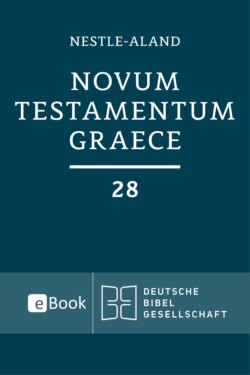Читать книгу Novum Testamentum Graece (Nestle-Aland) - Группа авторов, Nestle-Aland - Страница 40
На сайте Литреса книга снята с продажи.
2.1 Revision and Correction of the Critical Apparatus of the Whole Edition
ОглавлениеThe distinction between consistently cited witnesses of the first and second order has often caused uncertainties and complications. It was difficult to discover, for example, whether a consistently cited witness of the second order was not explicitly cited because it agreed with the majority reading or because it had a lacuna, and so we have given up this distinction. From now on all manuscripts cited consistently for the respective writing will be listed for passages with a positive apparatus (see also pp. 55*f.). If a witness declared as consistently cited in the Introduction does not appear at a passage with a positive apparatus, the only possible reason is a lacuna or illegibility.
Abandoning the distinction between consistently cited witnesses of the first and second orders increases the number of apparatus notes. At the same time, however, we have rearranged the apparatus for more tightness and clarity. Witnesses not cited consistently are listed only if they contribute variants of text-historical relevance. Unless there are particular reasons not to do so, the variants of consistently cited witnesses are given in full, even if they differ from other consistently cited witnesses in detail only. The appendix containing variae lectiones minores has been retained, but it is confined to readings which would have disturbed the clarity of the main apparatus.
In the context of the NTTranscripts project (http://nttranscripts.uni-muenster.de/) and of transcription of manuscripts for the Editio Critica Maior the Nestle-Aland apparatus notes were checked systematically. This brought about increased precision in the citation of Greek manuscripts.
Conjectures are no longer cited in the apparatus. This was not an easy decision for the editors, because these often indicate passages of particular text-critical and exegetical interest. However, mere citation of a conjecture without a bibliographical reference to the source is unsatisfactory. In this regard an index of all conjectures in former Nestle-Aland editions produced by the research group New Testament Conjectural Emendation at the VU University Amsterdam will be of assistance. The researchers involved in this project are Jan Krans, Bert Jan Lietaert Peerbolte, Silvia Castelli and Bart Kamphuis.
The apparatus of the Catholic Letters in the ECM shows how extensive the treatment of inscriptio and subscriptio would have to be, if they were to be treated in the same way as the New Testament text. For the sake of focusing on essentials, the subscriptions will no longer appear in the NA apparatus. The inscriptions other than those of the Catholic Letters remain unchanged for now. For the Catholic Letters, however, they are given in their main forms as transmitted by representative witnesses.
Furthermore, the notes pauci (pc) and alii (al) indicating that, apart from the witnesses cited explicitly, there are a few or more additional witnesses for a variant, have been abandoned. The main reason for this is that these notes could easily lead to a mistaken conclusion that apparatus entries without pc or al were exclusively supported by the witnesses cited. However, even where the ECM is extant pc and al cannot be used in a precisely defined way, because full collation of all the manuscripts would yield more witnesses for known variants.
Concatenation of apparatus entries by et or sed has been criticised, because often the witnesses listed in support of the text at the second variation unit were erroneously referred to the combination of both passages. Now attestations that were concatenated previously are cited separately, and cf points to possible relations between variants, where a hint appeared to be useful.
Latin abbreviations and connecting texts are kept as simple as possible. They are translated in the general list of abbreviations (Appendix IV).
The apparatus of references in the outer margin has been thoroughly revised (see pp. 82*-84*).
Appendix III in NA27, Editionum Differentiae, is not included in the 28th edition, because the effort of revising it would not have been in reasonable proportion to its prospective usefulness. Today an index of variants based on a comparison of modern editions should be linked to the texts themselves. It is planned that such a tool will become a component of the digital Nestle-Aland, as soon as the necessary funding is available.
